 Introduction to Archaeology
and Palaeoanthropology:
Introduction to Archaeology
and Palaeoanthropology:
 Introduction to Archaeology
and Palaeoanthropology:
Introduction to Archaeology
and Palaeoanthropology:
Humanity's Journeys
Dr. Kathryn Denning
Anth 2140, Sept 2006 - Apr 2007
24 Oct 2006... Welcome!
Plan for class
1) Announcements
2) Brief recap of macroevolution / the story of life on Earth...
3) Primates... up to about pg. 90 of the text.
Announcements:
Information about Assignment 1, due in tutorial tomorrow.
Reading assignment for next week
Quiz #2 to be held in tutorial Weds Nov 1 at the start of class. 25 minutes long. Review guidelines are here. We covered some of this last week, and will be covering much of the primate material today in class.
Tomorrow in tutorial: review for quiz
FIRST: RECAPPING FROM LAST WEEK....
Last week, there was a request to review the relationship of DNA to gene to chromosome. Here are some useful diagrams:
The scale of cells etc:
http://www.accessexcellence.org/RC/VL/GG/comparative.html
The Cell, the Chromosome, and DNA
http://www.accessexcellence.org/RC/VL/GG/chromosome.html
The Chromosome, the Gene, and DNA:
http://www.accessexcellence.org/RC/VL/GG/genes.html
DNA structure
http://www.accessexcellence.org/RC/VL/GG/dna2.html
Some other great diagrams are available here: http://www.accessexcellence.org/RC/VL/GG/index.html#Anchor-Genetics-35326
Also from last week...
Locating ourselves in time
See handout.
What are the key dates for biological evolution? (All dates are approximate!)
|
1 |
2 |
3 |
4 |
|
|
Date on a one-year calendar[1] |
Actual Date[2] |
What was new? |
Notes on Extinctions etc. in terms of Geological periods |
GEOLOGICAL PERIODS Only start date is given. Dates are approximate. |
|
Jan 1 |
15 bya |
the universe formed |
|
PRECAMBRIAN |
|
Sept 24 |
4.5 bya |
Earth formed |
|
|
|
Sept 25 |
4 bya |
bacteria appeared |
|
|
|
Nov 15 |
1.7 bya |
multicellular organisms appeared |
|
|
|
Dec 17 |
570 mya
|
complex organisms, jellyfish, worms, invertebrates |
Explosion of biodiversity in Cambrian period |
CAMBRIAN 570 MYA |
|
Dec 19 |
510 mya |
fish, coral, vertebrates |
500 mya (late Cambrian) massive extinction. 440 mya (Ordovician), large extinction. |
ORDOVICIAN 500 MYA
|
|
Dec 21 |
425 mya |
land plants, insects, jawed fish, air-breathing animals first forests 395 mya |
Around 365 mya, Devonian extinction (70% of species lost) |
SILURIAN 430 MYA
DEVONIAN 395 MYA |
|
Dec 23 |
350 mya |
amphibians and reptiles (dinosaurs appeared 230 mya) mammal-like reptiles (therapsids) 280 mya (therapsid - an early group of mammal-like reptiles, ancestors of later mammals) egg-laying mammals 225 mya Great Age of Dinosaurs 190 mya toothed birds 190 mya |
Around 245 mya (end Permian extinction), 96% of all species eliminated, including 75% of all vertebrates Around 200 mya (late Triassic extinction) 25% of species eliminated |
CARBONIFEROUS 345 MYA PERMIAN 280 MYA TRIASSIC 225 MYA JURASSIC 190 MYA
|
|
Dec 25 |
150 mya |
lots of reptiles, fish, amphibians modern birds placental & marsupial mammals placental mammal - a member of the infraclass Eutheria that includes placentals |
n.b. continents all one (Pangaea) until splits start ca. 200 mya |
CRETACEOUS 136 MYA |
|
Dec 26 |
65 mya
|
mammals (warm-blooded or homeothermic, i.e. able to regulate own body temperature, and live in more climates; increased investment in offspring; increased brain development) |
65 mya Cretaceous-Tertiary boundary (mass extinction, 85% of all species eliminated, including dinosaurs) |
TERTIARY 65 MYA Tertiary Epochs, below Paleocene 65mya
|
|
The information above is here for context and to assist your understanding of the 'big picture' of evolution. The next few weeks of the course will cover primates and hominid evolution. The second half of the course will cover the events of "Dec 31st".
|
||||
|
|
60 mya |
primates (more like prosimians) with grasping hands, opposable thumbs, stereoscopic vision, nails, collarbone, 1-2 offspring at a time-primate - an order of mammals based on original adaptation to arboreal life including binocular vision and grasping hands. Includes fossil and modern prosimians, monkeys, apes, humans |
Weather everywhere is tropical 40 mya: continents near present positions |
Eocene 55 mya Oligocene 34 mya |
|
Dec 29 |
35 mya |
monkeys and apes (anthropoids): flatter faces, nonmobile ears, very dextrous hands |
33 mya late Eocene extinction, loss of many mammals – global cooling |
Miocene 23 mya |
|
|
15 mya |
ape-like ancestors of humans (hominoids), e.g. Proconsul |
Miocene |
|
|
Dec 31, 10:30 pm |
4 mya |
human-like beings (hominids: Australopithecus afarensis and onwards to Homo): bipedal, bigger brain, reduction of face, teeth, jaws |
Pliocene |
Pliocene 5 mya Pleistocene 1.8 mya |
|
Dec 31 Stone tool use: 11:00:00 pm Agriculture: 11:59:20 Writing: 11:59:51 0 AD: 11:59:56 Now Nuclear weaponry, global culture, space travel |
100 000 ya
anatomically modern humans (Homo sapiens sapiens): larger brain, chin, smaller brow ridges, lighter skeleton, smaller teeth and jaws |
11 000 ya, substantial extinction of large mammals (climate change)
now – the sixth great extinction? |
Holocene 0.01 mya |
|
[1] This metaphor comes from Carl Sagan, Dragons of Eden, 1977 p15
[2] 1 billion = 1 000 000 000 1 million = 1 000 000 bya = billion years ago mya = million years ago
And now...
Locating ourselves within the sweep of biological diversity!

Remember... most of the species which have ever existed are extinct!
And remember: We human beings are the result of evolution, but remember the chance events included! There are many moments at which our lineage might have been obliterated, or might just have not developed into us. (see last week)
If you like, visit the Cambrian: http://www.pbs.org/wgbh/evolution/library/03/4/l_034_02.html
Also note: key term: common ancestry - if two groups evolved from the same earlier group, then they have common ancestry
-------------------------------------------------
Naming species - we use "binomial nomenclature" (Linnaeus)
| Genus | species | subspecies |
| Homo | sapiens | sapiens |
Always write as Homo sapiens. Generally, italicize.
Taxonomies are meant to organize diversity in an understandable way, but also to show evolutionary relationships... and so taxonomies develop and change as we learn more about species, either from their forms or from their genetics. (Can't organize according to appearance alone because of convergent evolution, whereby species that are quite separate genetically can look quite similar... e.g. sharks and dolphins are completely different organisms but have some superficial similarities)
(convergence: http://www.pbs.org/wgbh/evolution/library/01/4/l_014_01.html http://www.pbs.org/wgbh/evolution/library/01/4/l_014_02.html
Human Taxonomy
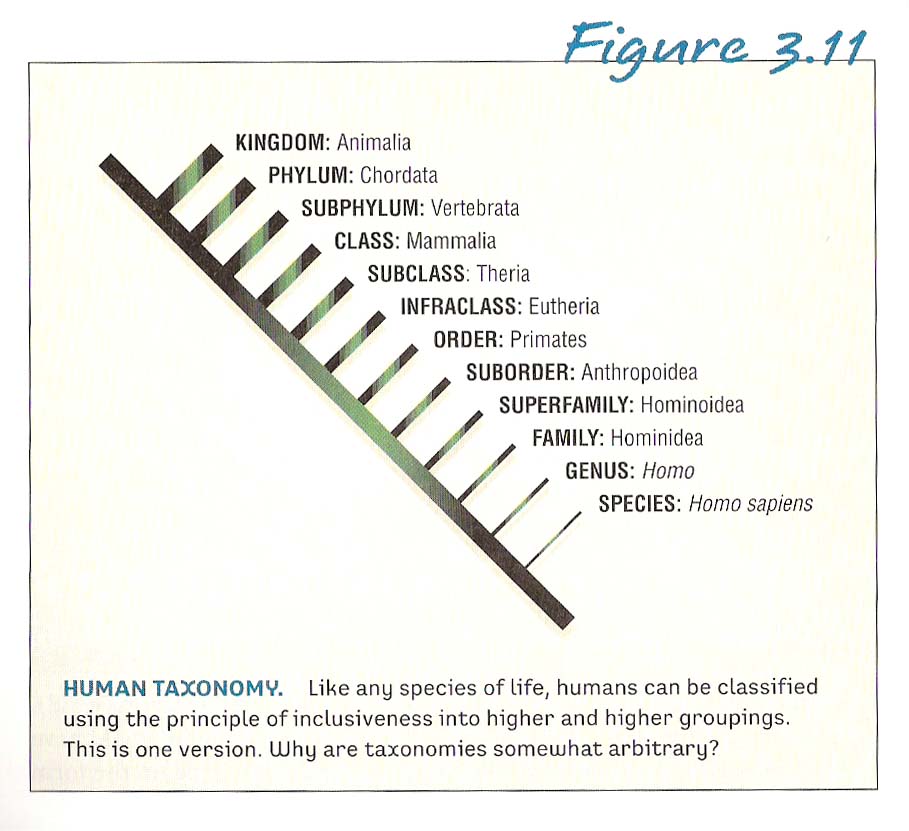
| TAXONOMIC DIVISION | OURS | NOTES |
| Domain | - Eukarya | (Eukaryotes - cells with nuclei) |
| Kingdom | - Animalia | (Animals, i.e. not plants or fungi etc) |
| Phylum | - Chordata | (spinal cord) |
| Subphylum | - Vertebrata | (vertebrate - backbone) |
| Class | - Mammalia | (includes monotremes like the platypus, and marsupials like the kangaroo, which are also mammals but different from us reproductively. We are eutherian mammals. ) |
| Order | - Primates | (prosimians
e.g. lemurs, monkeys, apes, us, our extinct close relatives) text - prosimian - a suborder of primates that is ancestral to later primates. Characterized by small body size and frequently nocturnal adaptations. Modern prosimians exist in Africa, Madagascar, and Southeast Asia |
| Suborder | - Anthropoidea |
(monkeys, apes, us, our extinct close relatives) text - anthropoid - members of Anthropoidea suborder, including monkeys, apes, and humans |
| Superfamily | - Hominoidea |
(apes, us, our extinct close relatives) text - hominoid - Superfamily of anthropoids including apes and humans. Traits include no tail and a large brain to body ratio |
| Family | - Hominidae |
(us and our extinct close
relatives, including Australopithecines) text - hominid - Humans and their bipedal ancestors since the time of divergence from the LCA of African apes and humans. |
| Genus | - Homo | (us and our extinct very close relatives) |
| Species | - sapiens | (the wise... as opposed to habilis, "the handy", or erectus, "the upright") |
| text - anatomically modern humans - modern form of the human species that dates back
to 100 kyr or more n.b. all anatomically modern humans are Homo sapiens, but there are a few very early Homo sapiens that aren't quite anatomically modern |
PRIMATE TAXONOMY
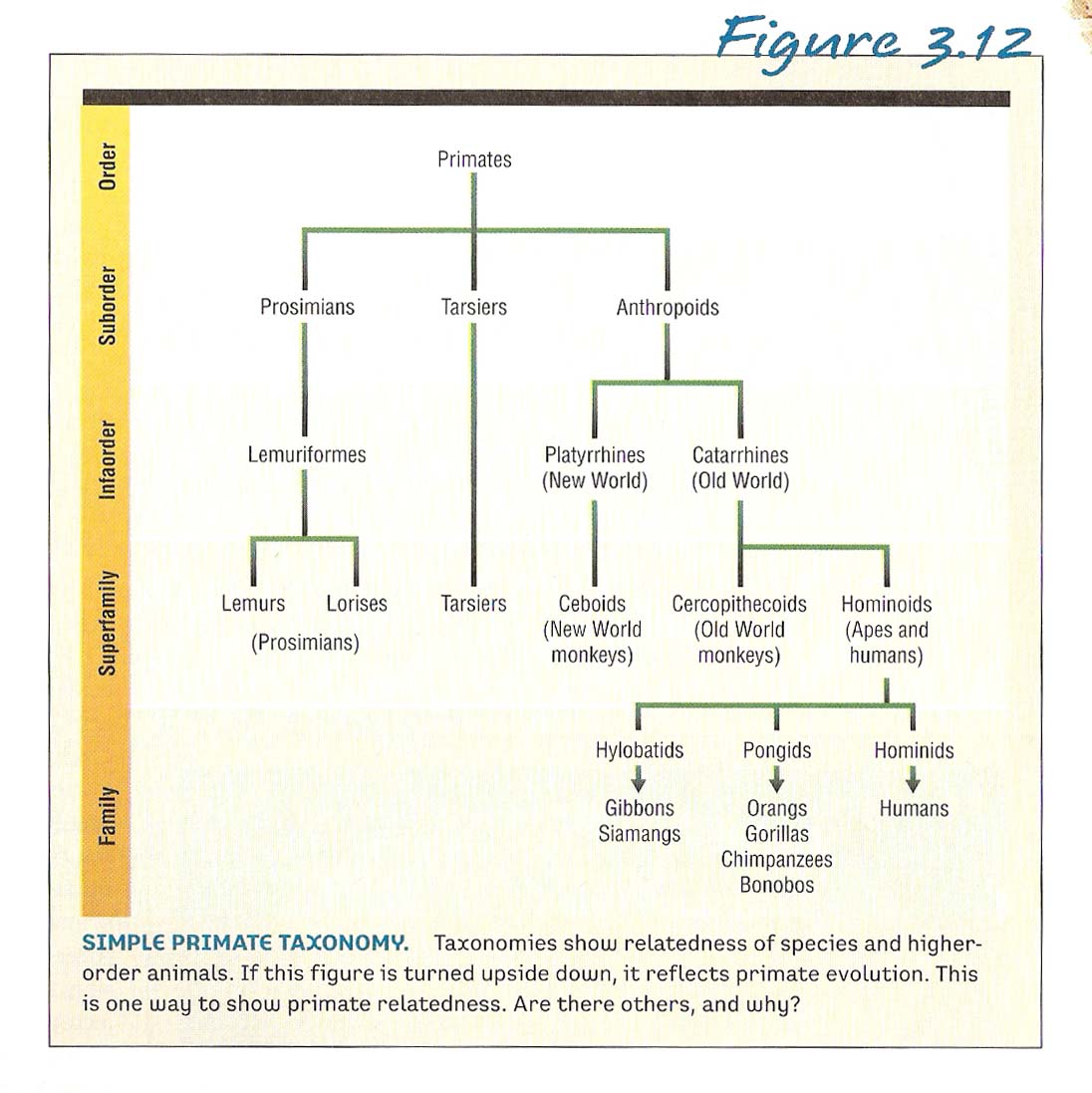
Quiz review question: Be able to fill in the following terms in their correct places on Fig 3.12 from the Rice book. (On the quiz, the terms would be provided to you in a list.) Primates, Prosimians, Lemurs, Lorises, Tarsiers, Anthropoids, Platyrrhines, Catarrhines, Cercopithecoids, Hominoids, Hominids, Pongids, Hylobatids, Gibbons, Orangs, Gorillas, Chimpanzees, Bonobos, Humans - You'll review this tomorrow in tutorial.
Another way of classifying the Primates: lemuriformes and lorisiformes together in a new suborder called Strepsirhini, and place tarsiers with monkeys, apes, humans in another new suborder called Haplorhini. Why? Because tarsiers are a little bit closer to anthropoids in their forms and their DNA, than they are to lemurs and lorises.
Similarly... there is much discussion about the precise degree of relatedness between humans and the great apes... and the consequences for correct taxonomy. For example, should it be Homo sapiens, Homo paniscus (rather than genus Pan), Homo troglodytes (rather than genus Pan)... maybe even Homo gorilla (rather than genus Gorilla)?
e.g. Reclassification proponent: www.pnas.org/cgi/content/abstract/1232172100v1
This is not just a matter of genetics but also of philosophy and ethics: would we treat chimpanzees and bonobos differently if they were also "Homo"?
Meet the Relatives.... Your Living Cousins, the Primates!
great galleries:
http://tolweb.org/tree?group=Primates&contgroup=Eutheria
http://animaldiversity.ummz.umich.edu/site/accounts/pictures/Primates.html
"primate - an order of mammals based on original adaptation to arboreal life including binocular vision and grasping hands. Includes fossil and modern prosimians, monkeys, apes, humans"
230 species of nonhuman primates (and dropping...)
Nonhuman primates are very good at being what they are, i.e. they are not pale imitations of us -- counter to earlier (religious and secular) notions of us evolving towards perfection, or monkeys being degenerate humans, having fallen from grace
Primate Characteristics (including us!)
Mammals - Placental (i.e. not marsupials or monotremes)
Body hair
Long gestation period with live birth (i.e. not eggs)
mammary glands
varied teeth ( a combination of incisors, canines, premolars, molars)
homeothermy
increased brain size
lots of capacity for learning and flexible behaviour
-overall, not all that specialized
SO more specifically.... WHAT MAKES A PRIMATE A PRIMATE?
* QUIZ review QUESTION: know the basics for the following primate traits in the Rice book pp 84-85: traits 2, 4, 5, 6, 7, 9, 10, 11, 12, 13 (amount of detail needed, for example, trait 4: vision: know that primates have binocular vision, and usually colour vision, and postorbital bars)
Primate Traits - traits that, taken together, distinguish them from other mammal orders:
1. position of foramen magnum (hole for the spinal cord) is on the underside of the skull rather than at the back (cat: http://www.digimorph.org/specimens/Felis_sylvestris_catus/ vs. squirrel monkey: http://www.digimorph.org/specimens/Saimiri_sciureus/338948/ vs. Homo sapiens http://www.digimorph.org/specimens/Homo_sapiens/ )
5. have bilateral symmetry, four appendages. We have very flexible arms, but somewhat more stable legs.
- that is, we have right and left sides, as well as a top and bottom.
compare to creatures with radial symmetry. http://en.wikipedia.org/wiki/Symmetry_(biology)
3. clavicle allows arms to swing and gives them strength for locomotion or lifting
(most four-limbed creatures have some clavicle: clavicles tend to be absent in those which use their front limbs for running/standing, and present in those which use front limbs for swinging, grasping )
e.g. human vs. horse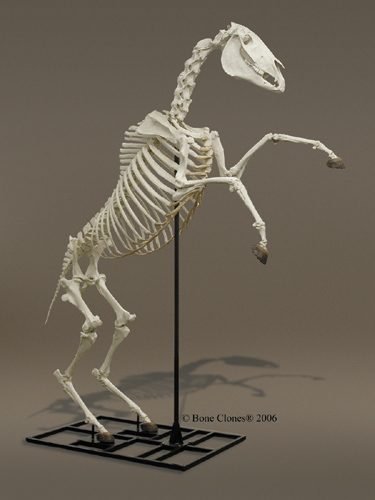
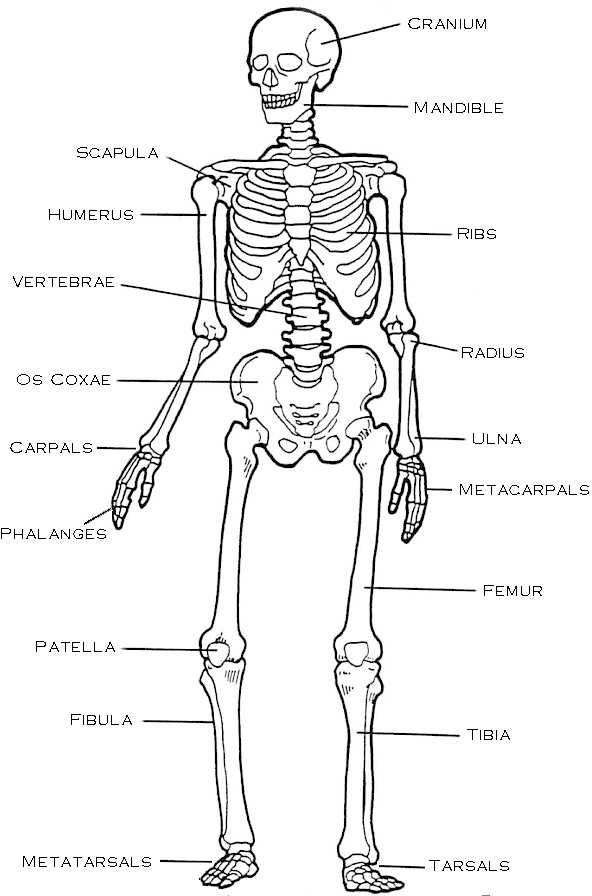
2. locomotion varies - quadrupedal (4-foot) or bipedal (2-foot) or brachiation (swinging), and combinations of these, but overall, hind-limb-dominant
terrestrial - ground living
arboreal - tree living
Primate Locomotion
Most primates are quadrupedal, using all four limbs in their locomotion.
Arm swinging (brachiation) is found among the apes.
Humans have that swinging shoulder too (suspensory shoulder - can hang from monkey bars)
Prehensile tails, found only among the new world monkeys, are used as an aid to locomotion.
Below: 4 main locomotor patterns, although n.b. primates are flexible and able to move in more than one way (unlike some animals, e.g. dogs, horses are more restricted in their locomotion)
Skeletons are from:
*Terrestrial quadruped (savanna baboon)
*Arboreal (bearded saki) New World - prehensile tail
*Vertical clinger/leaper (indri)
*Brachiator (gibbon)










4. vision is an important sense for primates. most primates today are arboreal; early primates probably were too. Primates have binocular vision and therefore depth perception. Also colour vision. Postorbital bars help frame the eye.
Primate skulls: http://www.digimorph.org/listbysubgroup.phtml?grp=Primate&sort=SpeciesName
Primate Senses and the Brain
Color vision is a characteristic of all diurnal primates, nocturnal primates lack color vision.
Forward-placed eyes... stereoscopic
vision allows depth perception... seen in most predatory species and in many
arboreal species ...
compare to rabbits or deer, where eyes are on sides of head
...
compare to rabbits or deer, where eyes are on sides of head

6. Most primates use their hands in locomotion. All primates use their hands to manipulate objects. (Humans and chimps have a true precision grip.)
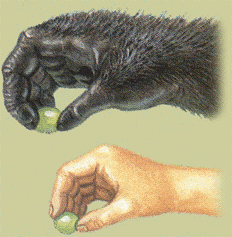
7. don't smell very well; they have small snouts and olfactory centres in the brain.
8. generalized dentition/teeth: incisors, canines, premolars, molars. Old World: 2.1.2.3, New World, 2.1.3.3

Primate dental variations:

Humans and apes quite similar, except humans have reduced canine size compared to all primates, and also no diastema (space to accommodate large canine). Prosimians have interesting specializations including dental comb for combing through fur or obtaining sap from trees.
Right: baboon canines
9. often sit in an erect or semi-erect position, and many are occasionally bipedal.
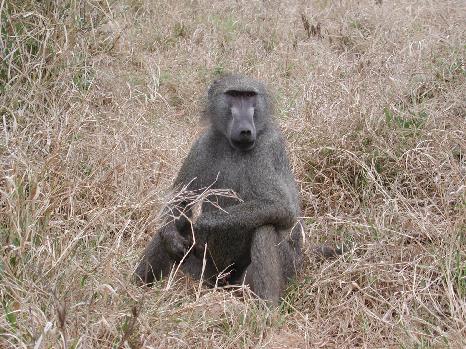
10. flat nails rather than claws (except for prosimians, which have claws). They also have pads on the ends of their fingers.

vs. prosimian (lemur) hands http://info.bio.sunysb.edu/rano.biodiv/Mammals/LemurHands.html
11. general diet, i.e. most are omnivores - can digest plant and animal foods
12. brain/body ratio is high. primate brains, relative to their bodies, are larger and more complex, and they have the ability to learn most of their behaviour, i.e. it isn't all simply instinct
13. primates take good care of their infants, which are dependent upon their parents for survival and have to be taught social skills and survival skills.
Primate Behavior
Primates exist in a tremendous range of shapes and sizes, from the pygmy marmoset to the gorilla. They also have a host of different behaviour patterns:
-some live in large groups, others in small groups, pairs, or mostly alone
-eat anything from bugs to fruit to other animals
- in some species, males and females look the same, and in others they differ
- live anywhere from snow to tropics

e.g. Japanese Macaque
http://primates.com/snowmonkeys/snowmonkey.html
e.g. Pygmy Marmoset: http://www.rarespecies.org/pygmy2.htm


Pygmy Marmosets.
Note the twins -- normal for callitrichids (marmosets and tamarins)
--
cared for by both parents, father carries them
http://www.rarespecies.org/pygmy.htm
---
got to here in class on 24.
Photo gallery showing diversity of primates
http://primates.com/